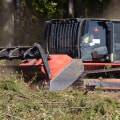A revolutionary land management practice is taking root in one of the picturesque town , nestled amidst rolling hills and lush landscapes. The people have long understood the value of preserving the natural beauty of their environment while seeking practical and cost-effective solutions for land development. Forestry mulching, an innovative and sustainable technique, has emerged as the answer to this conundrum. This method has garnered immense attention for its ability to clear land efficiently and significantly reduce land leveler costs in the region.
With its rich history and strong connection to the land, people has been searching for a land management solution that marries tradition with innovation. Enter forestry mulching, a method that has rapidly gained popularity in this community. This idyllic town has become a practical tool for land clearing and brush management and a catalyst for cost-effective and eco-friendly land development projects.
What Is Forestry Mulching?
Forestry mulching is a comprehensive land-clearing method that employs specialized machinery to grind trees, brush, and other vegetation into fine mulch. Unlike traditional land clearing methods, such as bulldozing or burning, which can cause considerable ecological damage and leave the terrain uneven, forestry mulching offers a more sustainable and eco-friendly approach. In this process, the land is cleared efficiently while preserving the natural structure of the soil. This is a critical aspect of forestry mulching, as it helps prevent soil erosion and reduces the need for extensive land leveling, ultimately resulting in substantial cost savings for landowners.
This method has been embraced due to its multifaceted advantages. Not only does it facilitate efficient land clearing, but it also contributes to sustainable brush management. Traditional practices can often be invasive, causing harm to the environment and the soil. In contrast, forestry mulching is non-destructive, ensuring the land remains ecologically intact. By retaining healthy soil structure and fertility, the residents can minimize the expenses of soil amendments and irrigation systems, which are typically necessary after conventional land-clearing methods.
Furthermore, forestry mulching is known for its speed and efficiency. Traditional land clearing and leveling processes can stretch over several weeks or months, incurring substantial labor and equipment costs. In contrast, forestry mulching offers a quicker and more streamlined solution, reducing labor expenses and speeding up land development projects. This swiftness translates into financial savings and allows landowners to get started on their ventures sooner, making it a highly attractive option for land development landscape.
Sustainable Brush Management
An essential feature that renders forestry mulching a highly attractive option for land management is its contribution to sustainable brush management. Conventional land-clearing techniques frequently encompass disruptive methods such as bulldozing, which can adversely affect the environment and the overall ecosystem. Conversely, forestry mulching offers a more eco-conscious alternative. This approach not only aids in preserving the natural environment but also plays a pivotal role in reducing land leveler costs.
Forestry mulching is a non-invasive method that grinds trees, brush, and other vegetation into fine mulch and then spreads it back onto the land. This approach efficiently clears the land and recycles the vegetation, thereby minimizing waste. The mulch acts as a natural soil conditioner, enriching the soil with organic matter. This, in turn, leads to improved soil quality and increased fertility, reducing the need for costly soil amendments and irrigation systems, which are typically necessary after traditional land-clearing methods.
Sustainable brush management is pivotal in reducing land leveler costs. By preserving the natural structure of the land and preventing soil erosion, forestry mulching ensures that the terrain is left in a more level and manageable condition. This translates to significant cost savings during the land leveling, as less effort and expense are required to achieve the desired surface. Therefore, the sustainable brush management aspect of forestry mulching not only benefits the environment but also the wallets of landowners.
Cost Savings On Land Leveler
Land leveling, an essential step in preparing the land for various purposes, can be expensive. Traditional land-clearing methods can leave the terrain uneven and damaged, requiring more extensive leveling work. On the other hand, forestry mulching ensures that the land is left in a more level and manageable condition. This significantly reduces the work and expense required to achieve the desired surface, translating to substantial cost savings for landowners.
The cost-saving benefits of forestry mulching don't stop there. Traditional land-clearing methods can stretch over several weeks or months, resulting in labor and equipment costs piling up. In contrast, forestry mulching is a faster and more efficient process. This reduces labor expenses and allows landowners to expedite their land development projects. By getting started sooner, they can capitalize on their investments and realize their land development goals more swiftly.
Furthermore, the reduced need for soil amendments and irrigation systems after forestry mulching adds to the cost savings. The mulch created during the process acts as a natural soil conditioner, enhancing soil quality and fertility. This means that property owners can minimize additional expenses typically required to maintain healthy soil and promote plant growth after traditional land-clearing methods.
Improved Soil Quality
In addition to effectively clearing the area, forestry mulching substantially contributes to improving the soil's condition. The landscape is frequently beaten, and traditional field-clearing techniques remove the soil's inherent nutrients. Repairing the soil's fertility and structure may require more expenditures in irrigation systems and soil supplements. However, the method used for forestry mulching is distinct. After being ground into a fine mulch, trees, shrubs, and other vegetation are dispersed uniformly across the ground. This mulch is a natural soil conditioner adding organic matter to the soil.
Introducing organic matter into the soil is pivotal in improving its quality. It helps the soil retain moisture more effectively, reducing the need for extensive irrigation. Furthermore, the organic matter enhances the soil's fertility, making it conducive to healthy plant growth. As a result, the costs associated with soil amendments and irrigation systems are significantly reduced, aligning to reduce land leveler costs.
Forestry mulching's commitment to improved soil quality benefits agricultural endeavors, landscaping, and land development projects in the region. The rejuvenated soil can support lush vegetation to make it more aesthetically appealing. Beyond the visual appeal, this improved soil quality plays a crucial role in sustainability, ensuring that the land remains fertile and productive for future generations.
Speed And Efficiency
Traditional land clearing and leveling processes can be time-consuming, often stretching over weeks or months. This extended timeline not only incurs additional labor and equipment costs but also delays land development projects, affecting the return on investment for property owners. In contrast, forestry mulching is a remarkably efficient process. Its specialized machinery grinds trees, brush, and vegetation into fine mulch in a fraction of the time it takes for traditional methods.
The efficiency of forestry mulching speeds up the land-clearing process and reduces labor expenses. With the ability to clear land more swiftly and with fewer resources, property owners can expedite their projects and minimize the costs associated with extended project durations. This rapid pace ensures that the land is ready for development sooner, allowing residents to capitalize on their investments more quickly.
For those aiming to reduce land leveler costs, the efficiency of forestry mulching is a significant advantage. The process leaves the land in a more level and manageable condition, reducing the need for extensive leveling work. This saves time and reduces the costs of heavy machinery and labor required for land leveling. As a result, forestry mulching emerges as an attractive solution for property owners looking to balance their land development goals with efficient and budget-conscious choices.
Contact A Heavy Equipment Attachment Supplier
When you're undertaking land development projects, it's essential to have access to the right heavy equipment and attachments. In this pursuit, CL Fabrication emerges as a key player in the region, offering a wide range of heavy equipment attachments to meet your specific needs.
CL Fabrication has established itself as a reliable and trusted supplier of heavy equipment attachments for various industries, including agriculture, construction, landscaping, and more. Whether you're a seasoned professional or a homeowner looking to tackle a project, they have the expertise and the equipment you need to get the job done efficiently and effectively.
From skid steer attachments to excavator buckets, CL Fabrication provides a diverse catalog of high-quality products designed to enhance the capabilities of your heavy machinery. Their attachments are not only durable and built to withstand rigorous use but are also engineered to improve efficiency, making your land development projects a breeze.
Furthermore, what sets CL Fabrication apart is its commitment to customer satisfaction. Their team of experts is readily available to provide guidance and assistance, ensuring you select the right attachments that suit your specific requirements. Whether you need land levelers, tree mulchers, or any other heavy equipment attachments, CL Fabrication is your one-stop shop for all your needs.



